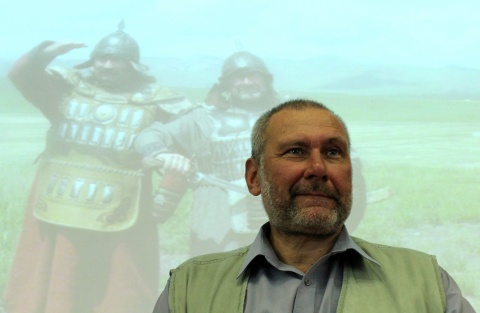 |
| Monastery Deir Mar Musa (Robert Mason) |
The origins of Jewish dietary or kosher laws (kashrut) have long been the subject of scholarly research and debate. Regardless of their origins, however, these age-old laws continue to have a significant impact on the way many observant Jews go about their daily lives.
 |
| Mike Foller hard at work. |
Roller, a graduate student from the University of Maryland, and students working with him this summer began digging test pits. Soon they started marking off 5-foot squares with string and scraping into the past. While sifting the dirt from each layer that they excavated, they found children's marbles, glass shards, pottery chips, buttons and bits from pipes favored by tobacco smokers.
As they dug deeper, they hit the rock foundations of homes built by coal miners as many as 120 years ago. The houses started collapsing in the 1940s and '50s. Locals remember one standing into the 1960s. Nowadays, people, if they give the grove a second look, would think nothing ever existed there.
Hernando De Soto's route through Florida is as elusive to modern archaeologists as the gold the famed Spanish explorer sought throughout the southeastern United States.
Ever since De Soto's 600 men set foot on the shores of Tampa Bay, arriving from Cuba almost 500 years ago, historians have debated the exact direction of his failed treasure-hunting expeditions as far north as Tennessee and North Carolina.
The Archaeological Survey of India (ASI) has begun restoration of Shore Temple at Mamallapuram, about 60 km south of Chennai, after the Pallava-era temple was hit by huge waves and inundated on June 19.
Archaeologists said restoration was required as cracks had appeared on the monument, which dates back to 7th century AD. Salt content in the sea water led to formation of cracks in the granite structure and they were being sealed using paper pulp as it absorbs salt from the structure and prevents it from becoming brittle.
Persistent rain failed to deter two budding archaeologists at the weekend as they carried out a sophisticated survey of ancient Kinloss Abbey.
Archaeologists from ORCA (Orkney Research Centre for Archaeology) taught local youngsters Owen Wheelton and Charlotte Johnson how to use specialist equipment in the hope they might unearth some of the 12th century building’s long-forgotten secrets.
Could an invasion of Ireland by Napoleon's French forces have succeeded and triggered Irish independence more than century earlier than it was actually won?
A team of experts -- led by Rubicon Archaeology -- has discovered a near pristine gun emplacement on Bere Island in west Cork.
They have also revealed tantalising hints that Britain's coastal defensive network was much more formidable than first thought -- and would have left the French facing their own 19th Century version of D-Day and Germany's Atlantic Wall.
 |
| Archaeologist Prof. Nikolay Ovcharov speaking against a backdrop showing people dressed as Mongol warriors. Photo by BGNES |
At a press conference presenting the results of a recent expetition to Mongolia, Ovcharov said he and his team met and talked to local shamans to discuss the novel idea.
"I now have this as my cause and most probably in April and May next year we will have true shamanic rituals here in Bulgaria," said he.
 |
| Gold coins (illustrative) Flash 90 |
The coins were found hidden in a partly broken pottery vessel at the Appollonia National Park, where archaeologists say the former Crusader town of Apollonia-Arsuf once thrived. The dig is being carried out under the joint auspices of Tel Aviv University and the Nature and Parks Authority.
Latest Archaeology News On Ancient Digger







0 Comments:
Post a Comment
We appreciate comments, but we delete SPAM.